Fabio Pavanello
Invited: Neuromorphic architectures based on augmented silicon photonics platforms
Jul 07, 2024


Abstract:In this work, we discuss our vision for neuromorphic accelerators based on integrated photonics within the framework of the Horizon Europe NEUROPULS project. Augmented integrated photonic architectures that leverage phase-change and III-V materials for optical computing will be presented. A CMOS-compatible platform will be discussed that integrates these materials to fabricate photonic neuromorphic architectures, along with a gem5-based simulation platform to model accelerator operation once it is interfaced with a RISC-V processor. This simulation platform enables accurate system-level accelerator modeling and benchmarking in terms of key metrics such as speed, energy consumption, and footprint.
The Impact of Feature Representation on the Accuracy of Photonic Neural Networks
Jun 26, 2024



Abstract:Photonic Neural Networks (PNNs) are gaining significant interest in the research community due to their potential for high parallelization, low latency, and energy efficiency. PNNs compute using light, which leads to several differences in implementation when compared to electronics, such as the need to represent input features in the photonic domain before feeding them into the network. In this encoding process, it is common to combine multiple features into a single input to reduce the number of inputs and associated devices, leading to smaller and more energy-efficient PNNs. Although this alters the network's handling of input data, its impact on PNNs remains understudied. This paper addresses this open question, investigating the effect of commonly used encoding strategies that combine features on the performance and learning capabilities of PNNs. Here, using the concept of feature importance, we develop a mathematical framework for analyzing feature combination. Through this framework, we demonstrate that encoding multiple features together in a single input determines their relative importance, thus limiting the network's ability to learn from the data. Given some prior knowledge of the data, however, this can also be leveraged for higher accuracy. By selecting an optimal encoding method, we achieve up to a 12.3\% improvement in accuracy of PNNs trained on the Iris dataset compared to other encoding techniques, surpassing the performance of networks where features are not combined. These findings highlight the importance of carefully choosing the encoding to the accuracy and decision-making strategies of PNNs, particularly in size or power constrained applications.
Security layers and related services within the Horizon Europe NEUROPULS project
Dec 14, 2023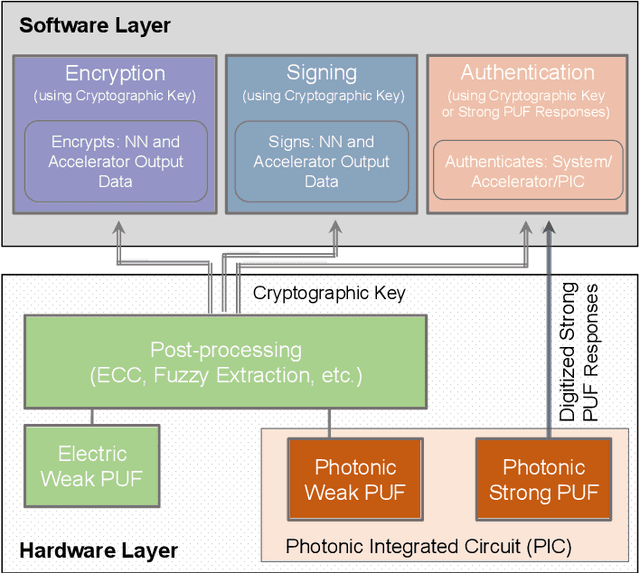
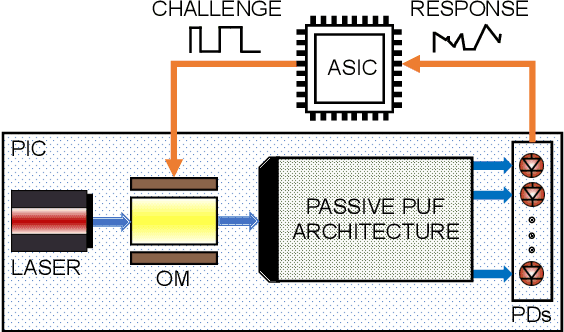
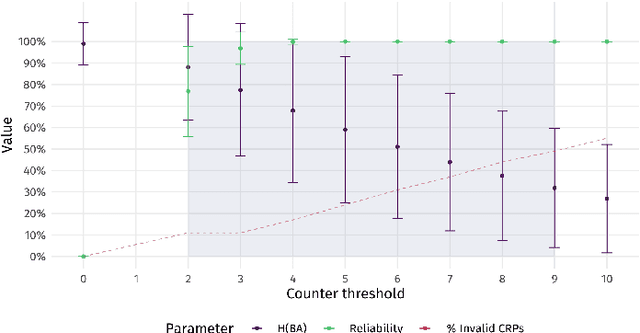
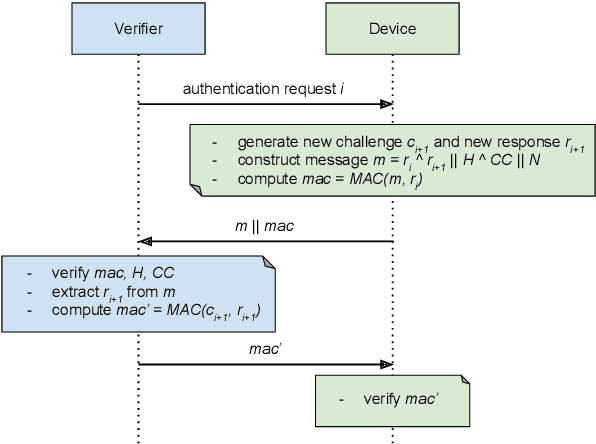
Abstract:In the contemporary security landscape, the incorporation of photonics has emerged as a transformative force, unlocking a spectrum of possibilities to enhance the resilience and effectiveness of security primitives. This integration represents more than a mere technological augmentation; it signifies a paradigm shift towards innovative approaches capable of delivering security primitives with key properties for low-power systems. This not only augments the robustness of security frameworks, but also paves the way for novel strategies that adapt to the evolving challenges of the digital age. This paper discusses the security layers and related services that will be developed, modeled, and evaluated within the Horizon Europe NEUROPULS project. These layers will exploit novel implementations for security primitives based on physical unclonable functions (PUFs) using integrated photonics technology. Their objective is to provide a series of services to support the secure operation of a neuromorphic photonic accelerator for edge computing applications.
NEUROPULS: NEUROmorphic energy-efficient secure accelerators based on Phase change materials aUgmented siLicon photonicS
May 04, 2023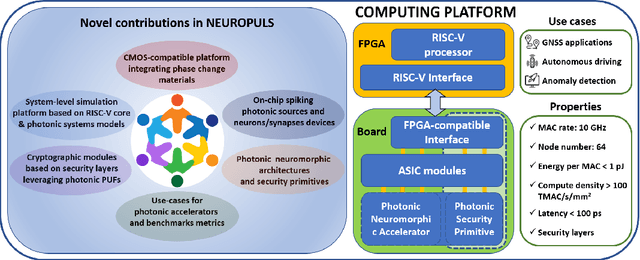
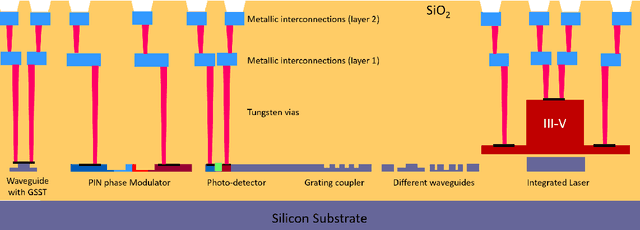
Abstract:This special session paper introduces the Horizon Europe NEUROPULS project, which targets the development of secure and energy-efficient RISC-V interfaced neuromorphic accelerators using augmented silicon photonics technology. Our approach aims to develop an augmented silicon photonics platform, an FPGA-powered RISC-V-connected computing platform, and a complete simulation platform to demonstrate the neuromorphic accelerator capabilities. In particular, their main advantages and limitations will be addressed concerning the underpinning technology for each platform. Then, we will discuss three targeted use cases for edge-computing applications: Global National Satellite System (GNSS) anti-jamming, autonomous driving, and anomaly detection in edge devices. Finally, we will address the reliability and security aspects of the stand-alone accelerator implementation and the project use cases.
Special Session: Neuromorphic hardware design and reliability from traditional CMOS to emerging technologies
May 02, 2023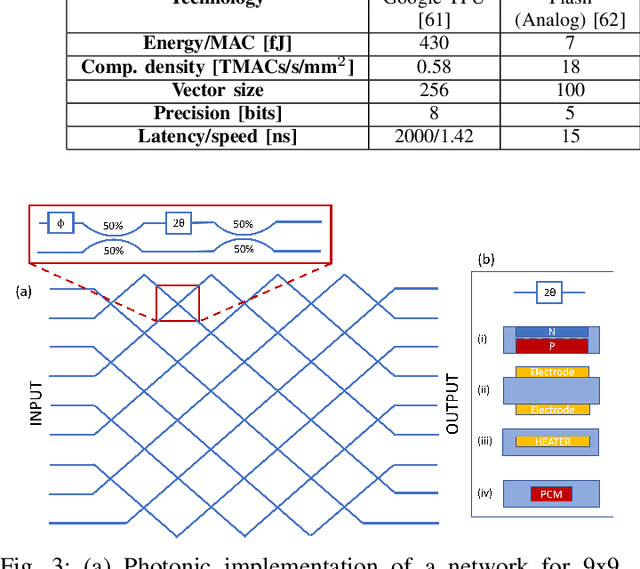
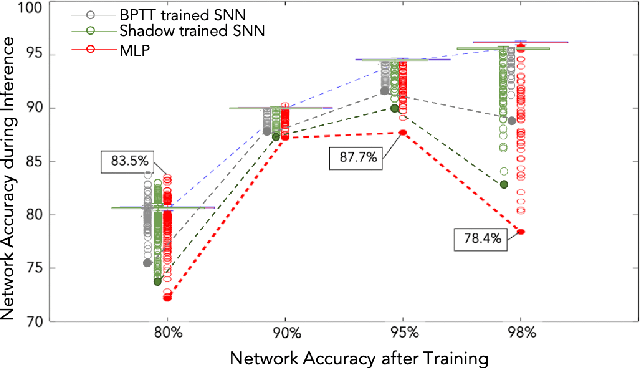
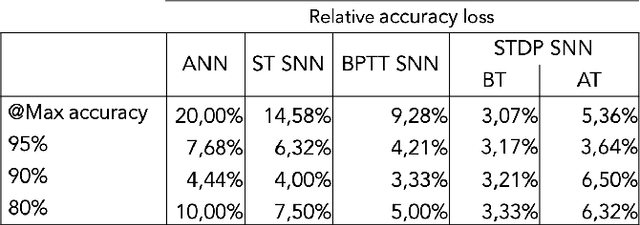

Abstract:The field of neuromorphic computing has been rapidly evolving in recent years, with an increasing focus on hardware design and reliability. This special session paper provides an overview of the recent developments in neuromorphic computing, focusing on hardware design and reliability. We first review the traditional CMOS-based approaches to neuromorphic hardware design and identify the challenges related to scalability, latency, and power consumption. We then investigate alternative approaches based on emerging technologies, specifically integrated photonics approaches within the NEUROPULS project. Finally, we examine the impact of device variability and aging on the reliability of neuromorphic hardware and present techniques for mitigating these effects. This review is intended to serve as a valuable resource for researchers and practitioners in neuromorphic computing.
Hitless memory-reconfigurable photonic reservoir computing architecture
Jul 13, 2022



Abstract:Reservoir computing is an analog bio-inspired computation model for efficiently processing time-dependent signals, the photonic implementations of which promise a combination of massive parallel information processing, low power consumption, and high speed operation. However, most implementations, especially for the case of time-delay reservoir computing (TDRC), require signal attenuation in the reservoir to achieve the desired system dynamics for a specific task, often resulting in large amounts of power being coupled outside of the system. We propose a novel TDRC architecture based on an asymmetric Mach-Zehnder interferometer (MZI) integrated in a resonant cavity which allows the memory capacity of the system to be tuned without the need for an optical attenuator block. Furthermore, this can be leveraged to find the optimal value for the specific components of the total memory capacity metric. We demonstrate this approach on the temporal bitwise XOR task and conclude that this way of memory capacity reconfiguration allows optimal performance to be achieved for memory-specific tasks.
 Add to Chrome
Add to Chrome Add to Firefox
Add to Firefox Add to Edge
Add to Edge